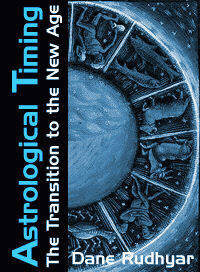 |
| Home | Bio | Art | Music | Literature | Civilization & Culture | Philosophy of Wholeness | Theosophy & Spirituality | Astrology |

ASTROLOGICAL TIMING
The Transition to the New Age by Dane Rudhyar, 1969 First published under the title Birth Patterns for a New Humanity
CONTENTS
PROLOGUE Where Do We Stand Today? PART ONE 1. Three Centuries of Crisis 2. Planetary Cycles 3. Cycles of Relationship PART TWO 4. Stars, Constellations and Signs of the Zodiac 5. From Buddha to Christ 6. The Structure of the Piscean Age Page 1 Page 2 Page 3 Page 4 Page 5 Page 6 Page 7 7. At the Gates of the New Age 8. The Aquarius-Leo Age PART THREE 9. The Zodiacal Earth-Field 10. As We Face the Future EPILOGUE |

CHAPTER SIX
The Structure of the Piscean Age - 2 The Twelve-Forld Pattern A closer analysis of the structure of the Piscean Age can be made by dividing it into twelve sub-periods of about 180 years. This, I believe, was attempted for the first time by Manly P. Hall, but instead of correlating these sub-periods with the twelve zodiacal signs, it seems more significant to relate them to the sequence of the twelve Houses of a chart, because the Houses refer to the series of basic experiences and tests through which an individual passes in the process of actualizing the potentialities inherent in his nature at birth. Beginning thus with the year 100-99 BC , we obtain the following series of sub-periods. Let me again repeat that the dates marking the start of such sub-periods are only approximate, as the basic 72-year period (i. e. one degree of precession) is not exact, and there have been also changes in calendar and two ways of going from BC to AD dates (I use the historian's usual way). 1. 100-99 BC to 82 AD The two fundamental Images of the Piscean Age are established: Caesar and Christ — the State and its Administrative Order backed by military power, and the great Symbol of Redeeming Love, God become man to save humanity. In India, we have the similar figure of the Boddhisattva dominating the new Buddhism (Mahayana). As we come to the last period of the Age (1883-2060) we see, on one hand, the "Big business-military complex" (or the Communist Party leadership in Soviet countries), and on the other, a still inchoate group of movements devoted in principle to a spiritual or idealistic form of democracy and personalism — with the rebellious youth of our day as the new Christians, as yet without Christ. Any "last" period of a cycle must solve the problem posited by the "first." The way any man dies is the solution (positive or negative as the case may be) to the life-problem his birth posited. II. 82 to 262 AD This period witnesses first the general reaction to the impulse started in the first phase of the cycle — then the slow substantiation and growth of those products derived from that impulse. Christianity develops and the Pax Romana proves itself under Trojan. III. 262 to 442 AD The Christian impulse is being disseminated; ideological arguments and political conflicts develop. Neither the Roman Empire, nor the Christianity of the Gospels survive; but the "surroundings" (third House) are permeated with the concepts of both. IV. 442 to 622 AD This is a period in which new races are moving around in space in order to find the geographical lands which "belong" somehow to them; i.e. their respective "homes." Great confusion everywhere. Every group seeks to take root including the Church (Gregory the Great, 600 AD). V. 622 to 802 AD This period begins with the prodigious growth of Islam, westward, northward and also eastward. The Normans and Magyars invasions are partially checked. A very masculine period of bursting forth. VI. 802 to 982 AD Charlemagne is crowned by the Pope Emperor of the West; but his empire is divided at his death, establishing the future pattern of much of European history. Later on, Otto the Great is proclaimed head of the Holy Roman Empire centered in Germany — and the imperial image henceforth haunts many rulers, including Napoleon I (who felt he was a reincarnation of Charlemagne) and Hitler. The end of the tenth century witnesses some degree of political stabilization everywhere: in China, after years of anarchy, the Song dynasty begins in 960; the New Mayan Empire in 987, the year of the start of the strong Capetian dynasty in France. By permission of Leyla Rudhyar Hill Copyright © 1969 by Dane Rudhyar and Copyright © 2001 by Leyla Rudhyar Hill All Rights Reserved.  Web design and all data, text and graphics appearing on this site are protected by US and International Copyright and are not to be reproduced, distributed, circulated, offered for sale, or given away, in any form, by any means, electronic or conventional. See Notices for full copyright statement and conditions of use. Web design copyright © 2000-2004 by Michael R. Meyer. All Rights Reserved. |
 |